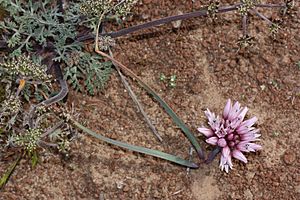Columbia River onion facts for kids
Quick facts for kids Columbia River onion |
|
|---|---|
 |
|
| Allium robinsonii in Grant County, Washington | |
| Scientific classification |
The Columbia River onion (also known as Allium robinsonii or Robinson's onion) is a very rare type of wild onion. It grows naturally in the US states of Washington and Oregon. Sadly, some scientists believe it might no longer exist in Oregon.
This special onion has been found in five counties in Washington: Ferry, Yakima, Grant, Franklin, and Benton. In Oregon, it was reported in Umatilla, Morrow, Gilliam, Sherman, and Wasco counties. It likes to grow in sandy and gravelly areas near the lower Columbia River and its smaller rivers. It usually lives in places less than 200 meters (about 650 feet) above sea level. People also grow it as an ornamental plant (meaning for its beauty) in other parts of the world, including Europe.
Contents
What Does the Columbia River Onion Look Like?
The Columbia River onion grows from small, egg-shaped bulbs. These bulbs are like tiny underground storage units, usually up to 2 centimeters (less than an inch) long. Unlike some other plants, it does not have underground stems called rhizomes.
Flowers and Stems
Its flowering stalks, which are the stems that hold the flowers, are quite short. They are usually less than 8 centimeters (about 3 inches) tall. The flowers themselves are bell-shaped and can be up to 9 millimeters (about a third of an inch) wide. They are typically white or light pink, with a red stripe down the middle of each petal-like part (called a tepal).
Inside the flower, you'll find purple anthers, which are parts that hold the pollen. The pollen itself can be yellow or gray. The plant's ovary, where the seeds will form, has a special crest or ridge on top.
Who Was B.L. Robinson?
This plant was named Allium robinsonii to honor a person named B.L. Robinson. He worked at the Gray Herbarium of Harvard University. A herbarium is like a library for dried plant specimens. Scientists often name new species after other scientists who have helped in the field of botany (the study of plants).
Why is This Onion Important?
The Columbia River onion is important because it is a rare species. Rare plants are special because they might have unique traits or play a specific role in their ecosystem. When a species becomes extinct, it means it is gone forever. This is why scientists and conservationists work hard to protect rare plants like the Columbia River onion. They want to make sure these plants continue to survive for future generations.

